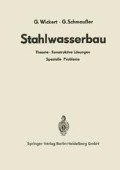Zusammenfassung
Seine größte Dichte weist das Wasser bei einer Temperatur von + 4 °C auf. Setzt dann bei weiterer Abkühlung die Bildung von Eis ein, dann dehnt sich das Wasser beim Kristallisieren plötzlich erheblich aus. Die Gewichtsverminderung oder Volumenzunahme wird rd. 9%. Unangenehm hierbei die Volumenänderung, da diese eine sprengende Wirkung mit sich bringt. Überall dort, wo Wasser stehenbleibt oder einsickern und gefrieren kann, ist an diese Erscheinung zu denken.
Access this chapter
Tax calculation will be finalised at checkout
Purchases are for personal use only
Preview
Unable to display preview. Download preview PDF.
Author information
Authors and Affiliations
Rights and permissions
Copyright information
© 1971 Springer-Verlag Berlin Heidelberg
About this chapter
Cite this chapter
Wickert, G., Schmausser, G. (1971). Eis. In: Stahlwasserbau. Springer, Berlin, Heidelberg. https://doi.org/10.1007/978-3-662-13037-7_13
Download citation
DOI: https://doi.org/10.1007/978-3-662-13037-7_13
Publisher Name: Springer, Berlin, Heidelberg
Print ISBN: 978-3-662-13038-4
Online ISBN: 978-3-662-13037-7
eBook Packages: Springer Book Archive

